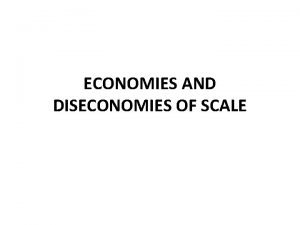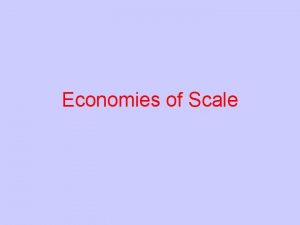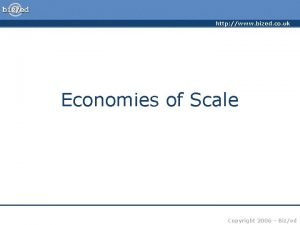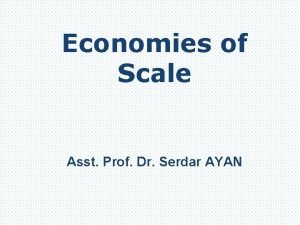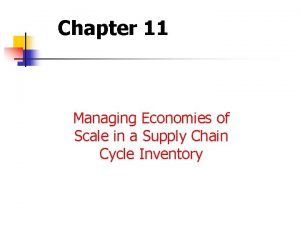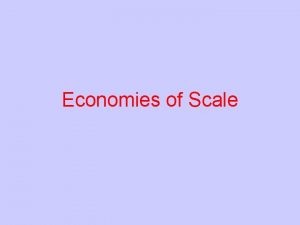ECONOMIES AND DISECONOMIES OF SCALE DEFINITION OF ECONOMIES









- Slides: 9

ECONOMIES AND DISECONOMIES OF SCALE

DEFINITION OF ECONOMIES OF SCALE • Economies of scale refer to reduced costs per unit that arise from increased total output of a product. For example, a larger factory will produce power hand tools at a lower unit price, and a larger medical system will reduce cost per medical procedure. Source: Economies Of Scale https: //www. investopedia. com/terms/e/economiesofscale. asp#ixzz 5 R 53 BT 6 tj


INTERNAL VS EXTERNAL ECONOMIES OF SCALE • Internal economies of scale are firm-specific, or caused internally, while external economies of scale occur based on larger changes outside of the firm. Both types result in declining marginal costs of production, yet the net effect is the same. External economies of scale are generally described as having an effect on the whole industry. Source: What are the differences between internal and external economies of scale? | Investopedia https: //www. investopedia. com/ask/answers/013015/what-aredifferences-between-internal-and-external-economies-scale. asp#ixzz 5 R 53 z. YG 1 u

TYPES OF INTERNAL ECONOMIES OF SCALE Ø Purchasing Economies - when large businesses often receive a discount because they are buying in bulk. Ø Managerial Economies - This is a form of division of labor. Large-scale manufacturers employ specialists to supervise production systems, manage marketing systems and oversee human resources. Ø Technical Economies - Large-scale businesses can afford to invest in expensive and specialist capital machinery. In the long run, they can produce more at a cheaper cost per unit Ø Risk Bearing Economies - The ability of large firms to spread risks over a large number of investors. Ø Financial Economies - Larger firms are usually rated by the financial markets to be more 'credit worthy' and have access to credit facilities, with favorable rates of borrowing. In contrast, smaller firms often face higher rates of interest on overdrafts and loans. Ø Marketing Economies - A large firm can spread its advertising and marketing budget over a large output and it can purchase its inputs in bulk at negotiated discounted prices if it has sufficient negotiation power in the market.

REASONS FOR OF EXTERNAL ECONOMIES OF SCALE Ø Improvement in Transport and Communication Links – As industries continue to grow, they have developed the overall infrastructure of countries which allows for easier and faster transport and also communication. This leads to a decreased cost per unit. Ø Training and Education – More and more institutions are starting up with a view to industry specific training. This raises the quality of the work force which can decrease average costs. Ø Development of Auxiliary Services – When industries develop, many other businesses develop that can provide goods and services for those industries. Because these businesses may be more specialized, they tend to have a lower production cost. Ø Cooperation Among Businesses – When businesses within industries pool together, they can benefit from cheaper costs.

DISECONOMIES OF SCALE Diseconomies of scale happen when a company or business grows so large that the costs per unit increase. Source: Diseconomies Of Scale https: //www. investopedia. com/terms/d/diseconomiesofscale. asp#ixzz 5 R 5 BDrl. Qs

SYMPTOMS OF DISECONOMIES OF SCALE • Poor Communication - As the business expands communicating between different departments and along the chain of command becomes more difficult. There are more layers in the hierarchy that can distort a message and wider spans of control for managers. • Demotivation - Workers can often feel more isolated and less appreciated in a larger business and so their loyalty and motivation may diminish. • Lack of Control and Coordination - It is harder to ensure that all workers are working for the same overall goal as the business grows. It is more difficult for managers to supervise their subordinates and check that everyone is working together effectively, as the spans of control have widened. A manager may be forced to delegate more tasks, which while often motivating for his subordinates, leaves the manager less in control.

THE END
 Types of diseconomies of scale
Types of diseconomies of scale Economies and diseconomies of work specialization
Economies and diseconomies of work specialization Advantages and disadvantages of diseconomies of scale
Advantages and disadvantages of diseconomies of scale Economies of scale diagram
Economies of scale diagram Outsourcing defintion
Outsourcing defintion Financial economies of scale
Financial economies of scale Risk bearing economies of scale
Risk bearing economies of scale Types of economies of scale
Types of economies of scale A key to reducing lot size without increasing costs is to
A key to reducing lot size without increasing costs is to Managing economies of scale in a supply chain
Managing economies of scale in a supply chain
